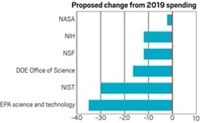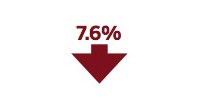Advertisement
Grab your lab coat. Let's get started
Welcome!
Welcome!
Create an account below to get 6 C&EN articles per month, receive newsletters and more - all free.
It seems this is your first time logging in online. Please enter the following information to continue.
As an ACS member you automatically get access to this site. All we need is few more details to create your reading experience.
Not you? Sign in with a different account.
Not you? Sign in with a different account.
ERROR 1
ERROR 1
ERROR 2
ERROR 2
ERROR 2
ERROR 2
ERROR 2
Password and Confirm password must match.
If you have an ACS member number, please enter it here so we can link this account to your membership. (optional)
ERROR 2
ACS values your privacy. By submitting your information, you are gaining access to C&EN and subscribing to our weekly newsletter. We use the information you provide to make your reading experience better, and we will never sell your data to third party members.
Research Funding
Trump again wants big cuts for science
Almost every agency’s funding takes a hit in 2021 budget proposal
by Andrea Widener , Britt E. Erickson , Cheryl Hogue
February 12, 2020
| A version of this story appeared in
Volume 98, Issue 7
For the fourth straight year, President Donald J. Trump has proposed slashing funding for US science agencies in his budget request to Congress. Legislators get to create funding bills, though, and Congress has not gone along with those cuts, giving most agencies increases instead.
“Today’s budget request from the White House is just another in a series of proposals to cut federal support for scientific research and innovation,” says Benjamin Corb, director of public affairs at the American Society for Biochemistry and Molecular Biology.
“We call on Congress to reject these proposed cuts, and we look forward to working with Democrats and Republicans on Capitol Hill to continue to increase investments in science and research,” Corb says.
Source: American Association for the Advancement of Science R&D Budget and Policy Program analysis.

In a conference call about the budget, White House science advisor Kelvin Droegemeier touted a 6% increase in proposed research funding. However, that was an increase over the even more extensive cuts Trump proposed for 2020, rather than the much higher funding levels agencies actually received from Congress.
Droegemeier also noted prioritization across the board for artificial intelligence and quantum computing, with agencies directed to increase allocations to those fields even if their overall budgets are cut.
Research agencies
NASA would be one of the few agencies to see its budget increase, up 12% to $25.2 billion. But almost all of that increase goes toward the Trump Administration’s goal to put humans on the moon again.
Most other agencies would see cuts if Trump’s budget is enacted. The National Institutes of Health, which last year saw an almost $2 billion increase in funding from Congress, would see that gain reversed by a nearly $3 billion (7%) cut to $38.7 billion in 2021 under Trump’s budget. That $38.7 billion would fund over 49,000 research grants, just slightly over what was funded in 2019. The National Institute of General Medical Sciences, which funds the most basic chemistry research at NIH, would see a cut of 9% to $2.7 billion in 2021.
At the National Science Foundation, the Trump administration asks for a 6% cut to $7.7 billion, down from $8.3 billion in 2020. That $7.7 billion would fund 10,700 grants, down from 11,200 in 2019. Within NSF, the chemistry directorate would face a higher-than-average 11% cut in the 2021 budget.
The National Institute for Standards and Technology faces an immense 32% cut in the president’s proposal, from just over $1 billion in 2020 to $701 million in 2021. As part of that, the agency’s science research and standards development division would lose 13% of its current funding.
In the Department of Energy, the Office of Science faces a proposed 17% cut to $5.8 billion. The Energy Efficiency and Renewables division faces decimating cuts of 74%, from $2.8 billion in 2020 to just $720 million in 2021. And yet again the administration proposes killing the Advanced Research Projects Agency for Energy (ARPA-E).
Regulatory agencies
Trump is asking Congress to chop science and technology at the Environmental Protection Agency by 32%, lowering this year’s $716 million budget to $485 million in 2021.
Among the cuts, the budget proposal eliminates a number of regional environmental clean-up and restoration programs, including those in San Francisco Bay, Puget Sound, Gulf of Mexico, Lake Champlain, and Long Island Sound. The proposal would chop Chesapeake Bay funding from this year’s $85 million to $7.3 million in 2021. It would maintain this year’s level of $320 million for Great Lakes restoration, however.
Trump is again proposing to halt $8.7 million in US funding to an international effort to help developing countries switch from chemicals that deplete stratospheric ozone to more environmentally benign ones. In addition, the president wants to slash climate-change programs at the EPA by 85% from $95.4 million in 2020 to $14.5 million in 2021.
The budget also proposes some EPA policy changes, most notably to prioritize EPA inspections of facilities that must have risk management plans because they use, make, or store highly hazardous chemicals.
The administration wants to pare back funding for the beleaguered US Chemical Safety and Hazard Investigation Board from $12 million in 2020 to $10 million in 2021. In his past three budget proposals, Trump has tried to defund the agency entirely. The CSB issued its own 2021 request to Congress for $13 million.
The Food and Drug Administration would receive a total of $6.2 billion, an increase of 4.5% compared with fiscal 2020. The request includes $3.3 billion in budget appropriations and $2.9 billion in user fees.
The budget proposes to increase user fees for regulatory review of e-cigarettes by $100 million. It also proposes to move the Center for Tobacco Products out of the FDA and create a new agency within the Department of Health and Human Services to regulate tobacco products, including e-cigarettes.
Under Trump’s proposal, the FDA would receive $5 million to regulate substances derived from cannabis, such as cannabidiol (CBD) in dietary supplements, food, and animal feed.
In light of growing demand for alternative proteins, synthetic food, and new ingredients, the budget request proposes a new $26.1 million FDA program to review novel biotechnology products, including cosmetics and food, paid for entirely by user fees.
While its overall budget would be cut, the Centers for Disease Control and Prevention would be directed to spend $175 million, an increase of $50 million compared with fiscal 2020, for activities related to global health security. The money would be used to protect Americans from emerging disease threats and epidemics, such as the novel coronavirus first identified in China and Ebola in West Africa. The CDC would also have to allocate $66 million, an increase of $14 million, to combat vector-borne diseases such as tick-borne diseases, which are on the rise in some regions because of changing climate.
UPDATE
The chart showing proposed changes from 2020 spending was updated on Feb. 13, 2020, to make clear that the changes are percentage changes from 2020 spending.





Join the conversation
Contact the reporter
Submit a Letter to the Editor for publication
Engage with us on Twitter